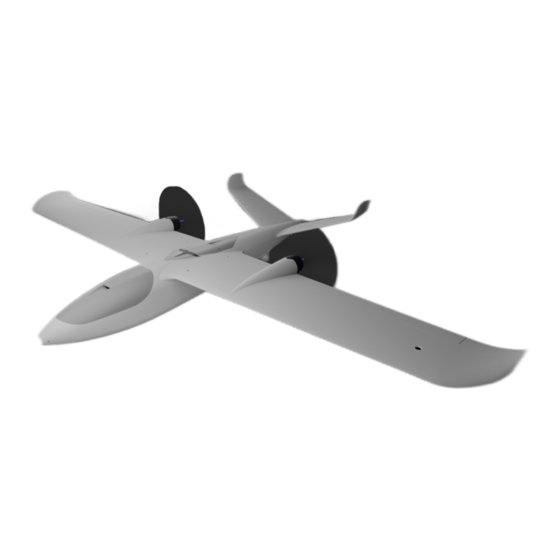
Summary of Contents for Titan Dynamics Raven
- Page 1 Titan Dynamics Titan Dynamics Webpage Visit our Facebook page Join our Discord server Titan Dynamics – Raven https://www.titandynamics.org/3dhangar/p/titan-raven Build & User Manual Revision 1.0 Page 1 of 18...
-
Page 2: Table Of Contents
Titan Dynamics Titan Dynamics Webpage Visit our Facebook page Join our Discord server Contents Section 1: Model Information ......................... 3 Section 2: Model Specifications & Performance ................4 Section 3: Required Build Materials ...................... 5 Section 4: 3D printing ..........................6 4.1: Things to know before you start printing. -
Page 3: Section 1: Model Information
Coming in at 1.6 meters of wingspan, this bird is capable of multiple hours of mixed agility flight. Speaking of agility, the Raven cuts through the air like a hot knife through butter – with purpose and excellent handling. Extensive CFD analysis went into creating Raven, giving it the unique look while preserving pitch, roll, and especially yaw stability. -
Page 4: Section 2: Model Specifications & Performance
Titan Dynamics Titan Dynamics Webpage Visit our Facebook page Join our Discord server Section 2: Model Specifications & Performance General Stats: • Wingspan: 1607mm • Wing area: 3205cm • Maximum take-off Weight: 5kg • Cruise speed: 60-70kph • Recommended prop diameter: 9-10 inches Aerodynamic Properties: •... -
Page 5: Section 3: Required Build Materials
Titan Dynamics Titan Dynamics Webpage Visit our Facebook page Join our Discord server Section 3: Required Build Materials Spars needed: (2) 8x1000mm (main wing spars) (4) 3x400mm (wingtips + aileron hinge) (2) 4x230mm (tail support) (2) 3x230mm (taileron hinge) (2) 2x70mm (front tail support – optional) Recommended motor &... -
Page 6: Section 4: 3D Printing
Section 4: 3D printing 4.1: Things to know before you start printing. 1. Titan Dynamics strongly recommends using Polymaker Polylite prefoamed LWPLA for the best results. This filament is much easier to tune your printer for and has less stringing than active foaming filaments. -
Page 7: Part Orientation
Titan Dynamics Titan Dynamics Webpage Visit our Facebook page Join our Discord server We recommend using the newest version of Ultimaker Cura. This link can be used to download our own slicer profile. 4.2: Part Orientation It is necessary to orient each part correctly on the build plate to avoid disconnected overhangs. -
Page 8: Tuning "Hole Horizontal Expansion
Titan Dynamics Titan Dynamics Webpage Visit our Facebook page Join our Discord server Wing1 (no skirt/brim) 4.3: Tuning “hole horizontal expansion” It is very important to check the fitment of the carbon rods in their holes on the first parts you print. Because everyone may be using different printers, materials and slicer settings, it is not possible to provide the models with a slicing profile and hole size that will work for everyone. - Page 9 Titan Dynamics Titan Dynamics Webpage Visit our Facebook page Join our Discord server When installed, use the new icon at the bottom of the left menu to choose tab diameter and thickness, then click on the model to add a tab at each point you think is at risk of warping or poor adhesion (typically parts with low surface area in contact with the print surface in relation to their height).
-
Page 10: Section 5: Assembly Of 3D Printed Parts
Titan Dynamics Titan Dynamics Webpage Visit our Facebook page Join our Discord server Section 5: Assembly of 3D Printed Parts Below are a few exploded views of the Raven to help with assembly. Page 10 of 18... - Page 11 Titan Dynamics Titan Dynamics Webpage Visit our Facebook page Join our Discord server Page 11 of 18...
- Page 12 Visit our Facebook page Join our Discord server The spar layout for Raven is as depicted below. None of the spars need to be glued in, they will all be retained by the printed parts. The two wing spars that intersect the fuselage are the joiners for the wings and the fuselage and can be removed completely from the fuselage and wing during transport.
- Page 13 Titan Dynamics Titan Dynamics Webpage Visit our Facebook page Join our Discord server • Medium CA glue should be used to assemble all fuselage parts • When first putting the glued parts together be sure to wipe any excess glue off before it sets.
- Page 14 Titan Dynamics Titan Dynamics Webpage Visit our Facebook page Join our Discord server • Use care when aligning parts for gluing. With medium CA, you should have a few seconds to get alignment right. Small mistakes in alignment can stack up and eventually lead to a part not fitting perfectly.
-
Page 15: Section 6: Final Setup & Tuning Tips
Join our Discord server Section 6: Final Setup & Tuning Tips • Titan Dynamics strongly recommends the use of Arduplane for all our models. • Give all control surfaces +- 35 degrees or more throw. • Setup motor rotation such that props rotate inwards towards the fuselage for added torque roll during differential yaw. -
Page 16: Section 7: Additional Images
Titan Dynamics Titan Dynamics Webpage Visit our Facebook page Join our Discord server Section 7: Additional Images Page 16 of 18... - Page 17 Titan Dynamics Titan Dynamics Webpage Visit our Facebook page Join our Discord server Page 17 of 18...
- Page 18 Titan Dynamics Titan Dynamics Webpage Visit our Facebook page Join our Discord server Page 18 of 18...









Need help?
Do you have a question about the Raven and is the answer not in the manual?
Questions and answers